The camel is still utilized in India, mainly for ploughing, transport of man and agriculture produce, drawing water from deep wells, and extraction of oil from oilseeds.
Camels can generate a draft force equivalent to 17-22 % of their body weight and can supply 1.1 hp bioenergy continuously for long periods.
The Indian Camel population is mostly confined to the north-western part of the country. Rajasthan, Haryana, Punjab and Gujarat inhabitants almost 93.12 % of Indian camel population (base, 1987). The other states where the camel occurs in substantial numbers are Uttar Pradesh and Madhya Pradesh. Eleven arid districts of Rajasthan contribute 78.86 % to the total Rajasthan camel population and 55.70 % to the Indian camel population.
Also Read: 3 Types of camel breeds.
1. Bikaneri camel
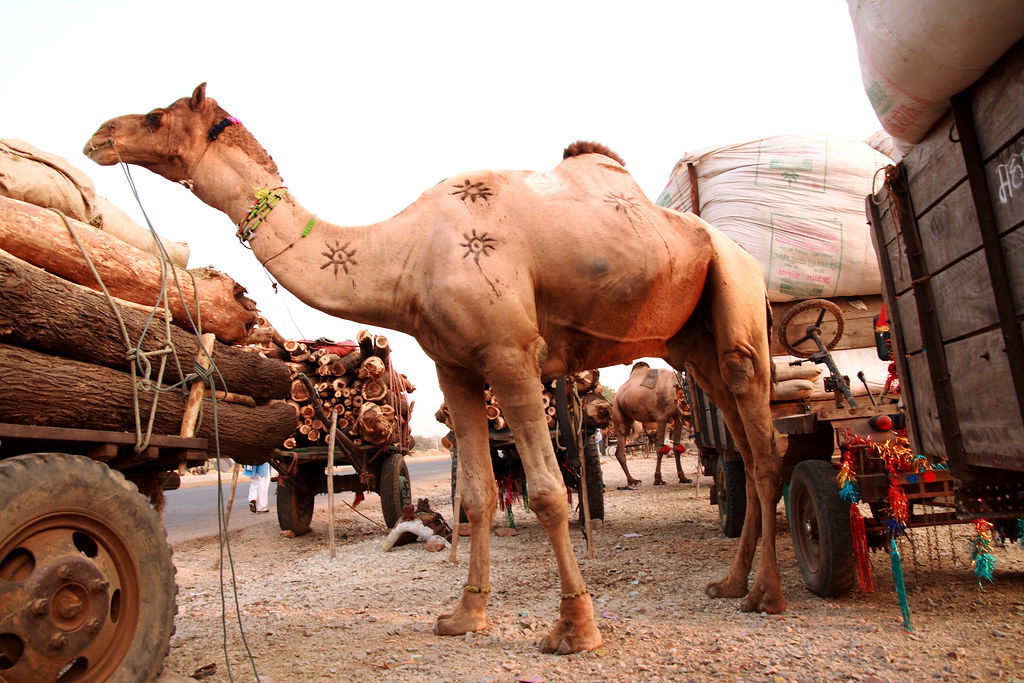
Bikaneri breed of the camel is one of the major camel breeds found in India. The breed derives its name from the city Bikaner which was established by Rao Bika in the 15th century and is known for better draught potential.
Habitat and Distribution
Bikaneri camels are predominantly bred in Bikaner and nearby districts, such as Sriganganagar, Hanumangarh, Churu, Jhunjhunu, Sikar and Nagaur of Rajasthan and adjoining parts of Haryana and Punjab state. The home tract of this breed is arid and sandy with extreme hot and cold climates.
Features
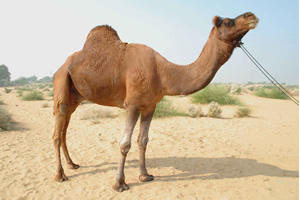
The camels of Bikaneri breed are heavily built and are attractive with a noble look. It has good height, strong built and active habits. The colour of the coat varies from brown to black, however, in some animals reddish tinge is also found. They have an asymmetrical body and slightly dome-shaped head. The forehead has a well-marked depression (stop) above the eyes, which is characteristic of this breed. The nose is long and extends up to two-third of the head. Some camels of this breed have a luxuriant growth of hair on their eyebrows, eyelids and ears, they are called ‘jheepra’. The chest pad is well developed and placed between angles of the elbow. The shoulders are strong, broad and well set to the chest. The neck is thick, fairly erect, with a marked curve giving a graceful carriage to the head. The udder is well developed in females.
2.Jaisalmeri camel
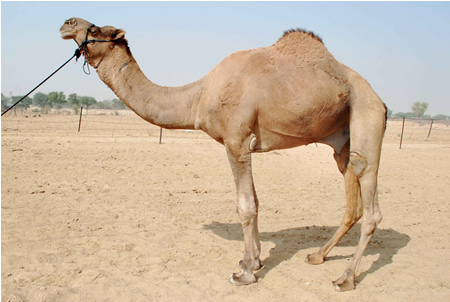
Habitat and Distribution
The breeding tract of Jaisalmeri breed encompasses the Jaisalmer, Barmer and part of Jodhpur district in Rajasthan. The breeding tract extends in the with very poor vegetation. Sand dunes are the typical features of the tract.
Features
The Jaisalmeri camels are of active temperament and are quite tall with long and thin legs. They have a small head and mouth with the narrow muzzle. The head is well carried on a thin neck and the eyes are prominent. The forehead is not dome-shaped and is without any depression above the eyes (stop). Also, there is no luxuriant growth of hairs on their eyebrows, eyelids and ears. The body colour is predominantly light brown. The Jaisalmeri camels have thin skin and short hairs on the body. The udder is mostly round in shape. It is a medium-sized breed of the camel.
The Jaisalmeri camel has good race potential and therefore was an important breed before the advent of modern camel cart. They were preferred in cavalries in the past life Ganga Risala which took part in World War I and II. Presently the Camel Corps constitutes an important wing of the Border Security Force of Indian para-military service.
3.Kachchhi camel
Also Read: 3 Types of camel breeds.
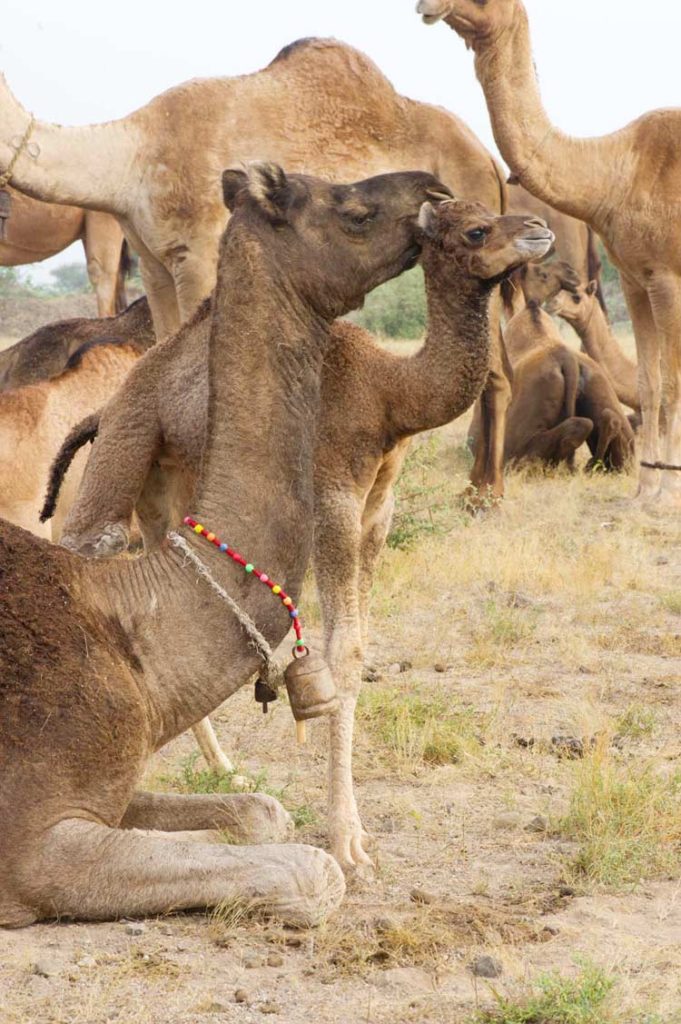
Habitat and Distribution
The Kachchhi breed inhabits the ran of Kachchh in Gujarat state. The major breeding tract encompasses the Kachchh and Bansakantha districts of Gujarat. The land is marshy with abundant salt bushes.
Features
The camels of this breed are generally brown to dark brown with the absence of hair on eyelids and ears. The body hairs are coarse. Head is of medium size without distinct “stop”. Body size is medium. Camels of this breed are heavy and dull in appearance. They are stouter and a little shorter. They have strong hindquarters, heavy legs, hard and thick foot pads and are well adapted to the humid climate and marshy land of Kachchh. In some animals, the lower lip is droopy due to which the teeth are visible from a distance. The udder is well developed and mostly round in shape.
4.Mewari camel
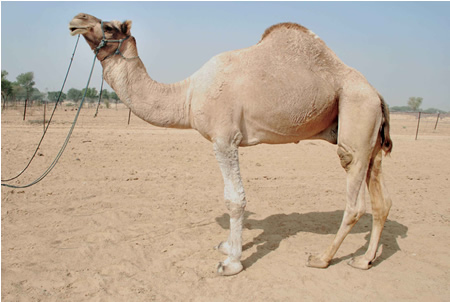
The Mewari breed of camel has derived its name from the Mewar area of Rajasthan and is well known for milk production potential.
Habitat and Distribution
The major breeding tract of the breed encompasses the Udaipur, Chittorgarh, Rajsamand districts and adjoining Neemuch and Mandsour districts of Madhya Pradesh. The camels of this breed can also be seen in Bhilwara, Banswara, Dundarpur districts and Hadoti region of Rajasthan, which can be considered as a minor breeding tract of the breed. fairly good vegetation and rainfall. Average height from main sea level is about 575 meters. The tract consists of hills of the Aravali in Mewar area.
Features
Genetic improvement of indigenous camels through conventional and molecular
Mewari camels are stouter and a little shorter than Bikaneri. They have strong hindquarters, heavy legs, hard and thick footpads. Well adapted to travel and carry loads across hills. The body hairs are coarse, which protects them from the bites of wild honeybees and insects. The body colour varies from light brown to dark brown but some animals are almost white, such variation in body colour is generally not seen in other breeds of the camel. The head is heavy, set on a thick neck. Unlike the Bikaneri camel, the Mewari camel has no ‘stop’, but its muzzle is loose. Ears are thick and short, set well apart, the tail is long and thick. The milk vein is prominent and the udder is well developed in females.
5.Jalori camel
Also Read: 3 Types of camel breeds.
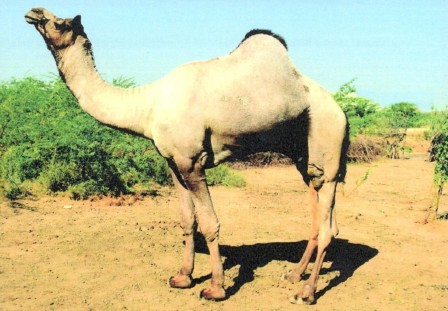
General description
Local Name/Synonyms: Jalori, Sanchori
Background for such name: Named after the habitat: Jalore Communities responsible for breeding: Dewasi are the traditional camel breeders
Geographical distribution and breeding tract
The Jalori camel derives its name from the place of rearing. The geographical distribution of the breed encompasses chiefly the Jalore and Sirohi districts of Rajasthan. The overall population of Jalori camels in the breeding tract was estimated to be 7906 heads.
Breed Characteristics
Body colour – The predominant colour of Jalori camels is brown. However, it varies from light brown to dark brown.
Head Profile- The head in Jalori camel is medium in size and is well carried on a thin neck. The eyes are prominent. Unlike Bikaneri camel, in Jalori camel, the forehead is not dome-shaped and has no “stop”, which is a name given to a depression on the frontal bone at the upper edge meeting the parietal bone. The supraorbital foremen, which is in the form of a deep fissure at the rostromedial margin of the orbit, is normal in-depth as compared to the Bikaneri camel where it is deep. The muzzle is narrow and mostly pointed in camels of Jalore district but rounded in the camels of Sirohi district. Ears are up-right and set well apart. The typical adaptive feature of desert camel, the “Jheepra” is absent in Jalori camel. The lower lip is not droopy as seen in Kachchhi camels.
Body and Stature- It is a medium-sized breed of Camel. The Jalori camels are of active temperament. The Neck and legs are thin. The body hairs are coarse in quality and medium in length. The Chest pad is well developed.
Udder Characteristics- The milk vein is small to medium in size. The udder is mostly round in shape. Each udder quarter has a small cone-shaped teat with two canals in it. The Jalori Breed is a multipurpose breed of camel and the animals of this breed are being utilized for milk production, tourism, riding and safari.
6.Kharai
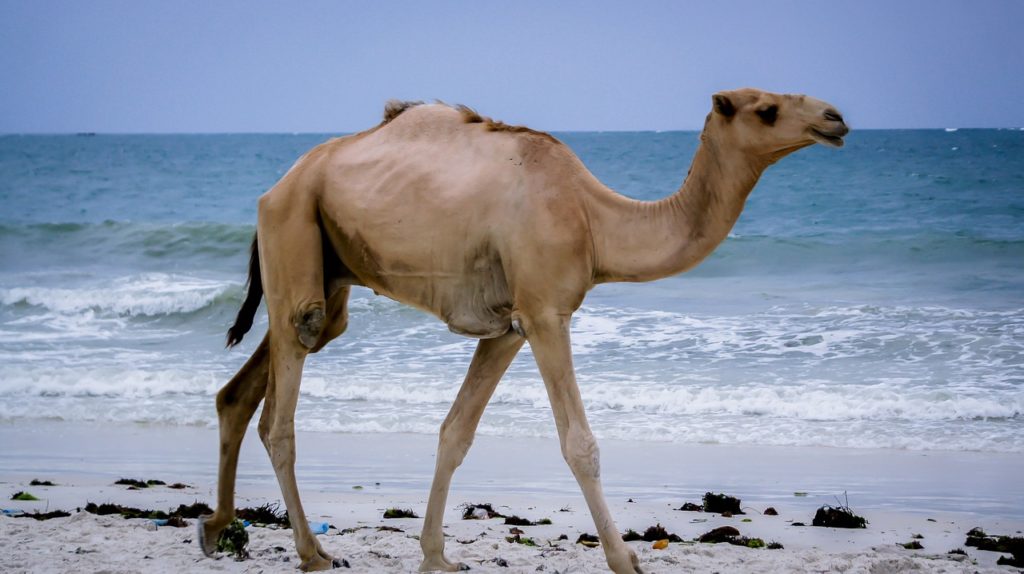
Kutch’s unique breed of camels that can swim in seawater – identified as Kharai due to its habitat and eating habits – has been recognized as a separate camel breed by the National Bureau of Animal Genetic Resources (NBAGR) located in Karnal, Haryana. Kharai has now become the ninth breed of camels found in India.
Now, Kutch has two identified breeds native to the region – the first being Banni buffalo that got the honours four years ago.
While NGOs and state agencies that applied for the status to the Centre got the news a few days back, chief minister Anandiben Patel announced the recognition at a public meeting held at Dayapar in Lakhpat in Kutch on Saturday.
Ramesh Bhatti, the programme coordinator of Sahajeevan, a Bhuj-based NGO that played an active role in the process, said that the camel breed is unique on many counts. The NGO along with other agencies such as Anand Krishi University and the state’s animal husbandry department had prepared breed descriptor and had conducted tests for the gene pool and other characteristics. The process took two years.
While camels are special to the desert regions, Kharai, also known as Dariyataru due to its ability to swim in deep waters of the sea, is more than an animal to carry the men or weight, said Bhatti. The camels exclusively survive in mangroves, eating grass and vegetation found in coastal regions. Due to their unique diet, they swim to islands near the shore for grazing.
Due to its unique abilities, the camels are seen in coastal and marshy areas found inhospitable by other breeds.
7.Mewati
9.Malvi
The Malvi camel, a very distinctive breed from northern Madhya Pradesh (India), which is characterized by considerable milk production potential. Although the Malvi camel has long been recognized as a distinct population by local camel breeders, scientists were previously not aware of the existence of this breed. Information about the distribution area, estimated population size, and physical characteristics of the Malvi camel is provided and the prevailing management and production system is described. It is concluded that the Malvi camel represents a valuable genetic resource and that steps are necessary to ensure its survival as a separate gene-pool. The way in which this breed was discovered also demonstrates the need for utilizing local indigenous knowledge in the identification and documentation process of animal genetic resources.
Source : nrccamel.icar.gov.in www.nbagr.res.in
I’m from Rajasthan